Things are getting a bit crazy, but there are some things you need to do before the end of the year to make a smoother transition into the tax season. The following are the most common items that are forgotten so make sure these things get done.
- Did you purchase equipment and/or furniture this year? If so, make sure you gather all of your receipts/invoices from these purchases to submit to your accountant. Computer software, subscriptions and office supplies are also tax deductible so include those amounts for your taxes.
- Obtain W-9 Forms from vendors and independent contractors. The Internal Revenue Service requires that you obtain W-9 forms when you make inventory and service purchases from a vendor. If you have paid anyone over $600 in labor and services or $5,000 in direct sales, then you need to collect a W-9 Form from them. The 1099’s are due by January 31st. If you pay rent to an LLC, you most likely need to file a 1099 for total rent paid. This is often missed so speak to your accountant about it.
- Gather receipts for meals and travel expenses. These include mileage and lodging expenses. Attending a business convention is only deductible if it directly benefits your business. The entertainment of business associates or clients is also deductible. Make sure you include any business expenses that you paid personally. Also, include any gifts given to clients/customers.
To utilize the Self-Employed Health Insurance Deduction, health insurance premiums that are paid through the practice should be added to your last paycheck in December as a fringe benefit if you’re a greater-than-2%-shareholder of an S-Corporation, and also offer a group plan to your employees that meets the Affordable Care Act guidelines. That amount is reported on your W2 and is subject to a federal withholding but exempt from Social Security and Medicare withholding. This may be added to the last paycheck in December with a check date on or before December 31st, or simply added to the Box 1 wages on your W2. Contact your payroll provider for further instruction.
- Do you still have all your fixed assets? Go through your list of fixed assets and inform your accountant if you no longer have items. There are two ways to write off a fixed asset. One way, which is the most common, is when a fixed asset is being scrapped because it is obsolete or no longer in use and there is no resale market for it. The second way is when an asset is sold and you receive cash or some other asset in exchange for the fixed asset. The amount of the write off depends on the price paid and the remaining amount of depreciation.
As mentioned previously, these are some of the most common items that are overlooked when you are doing your year-end tax preparation. However, these are imperative to do before the end of the year and before you send all of your information to your accountant. Therefore, complete these now to ensure a smoother transition to the new year and tax season.



You must be logged in to leave a reply.